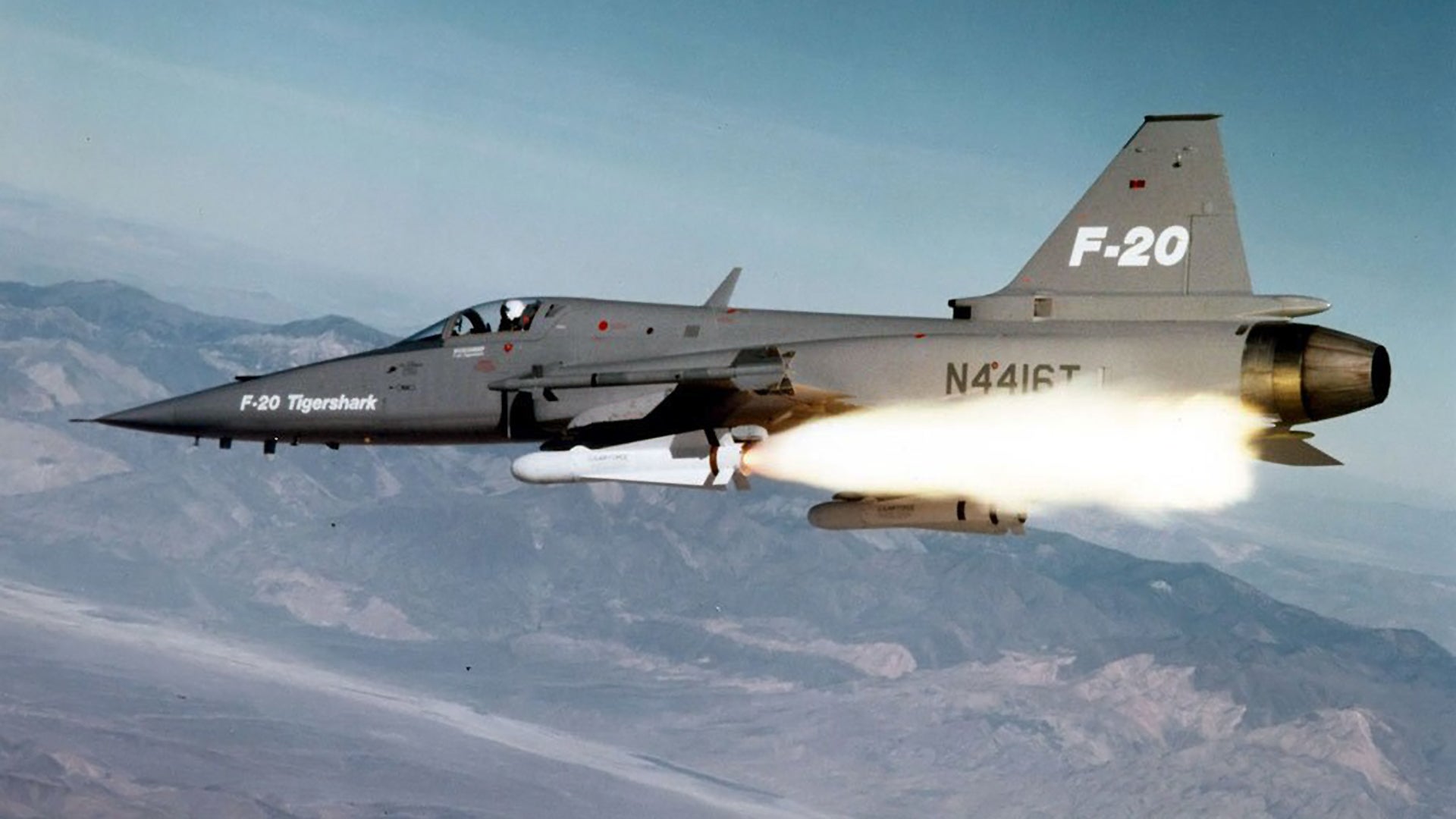Northrop’s F-20 Tigershark, an evolution of the company’s highly successful F-5E Tiger II—which itself was an evolution of the F-5A/B Freedom Fighter and The T-38 Talon—never made it into production, but many thought it should have. The aircraft provided high performance and multi-role capability on the cheap, both in terms of procurement and operating costs. But the Reagan administration’s loosening of export rules on military equipment, including fighters, allowed the already deep into production, larger and more advanced F-16 to edge out the F-20 on the world-wide fighter jet marketplace.
There were still a few opportunities for Northrop to get its self-funded fighter into production, with the Navy’s Fighter Weapons School—better known as Topgun—being in the market for a new highly maneuverable “4th generation” dissimilar adversary aircraft. In the end, here too the F-16 won out, giving birth to the hotrod F-16N (make sure to read all about F-16N and Topgun’s proposed F-20s here). By 1986, after over a billion dollars invested and the failure to produce a single customer, along with a spate of high-profile crashes, Northrop’s “people’s fighter” of sorts that was born out of the “Fighter Mafia” of the 1970s was finally put to rest.
The marketing surrounding the F-20 was somewhat unique. Seeing as it was a company program, with few government dollars invested, Northrop went about demoing the jet around the world and building some pretty awesome promotional materials around it. They even hired retired General Chuck Yeager to become the spokesperson for the program, which included him flying and personally endorsing the jet.
Maybe the best thing remaining of the F-20 is this awesome long-format promotional video that goes into the features of the jet. It does an awesome job at selling why the Tigershark was its own breed of fighter, and how it could get so much done without a large logistical footprint and with low operating costs.

Today the Tigershark concept lives on to a certain degree in aircraft like the JAS-39, JF-17, and advanced fighter-trainers like the FA-50. Some of the F-5E/F Tigers IIs still in service have been extensively upgraded to give them similar if not superior avionics to the F-20. But even with these upgrades, these jets lack the Tigershark’s upgraded mechanical systems and extreme performance. Maybe the closest thing to a modern F-20 was Northrop Grumman now defunct T-X contender, the Model 400. Sadly we may never know what this jet’s true performance capabilities were.
In some ways the F-20 makes more sense now than it did 30 plus years ago. As fighter aircraft have become so expensive to procure and maintain, some countries are left with fleets that are just a shadow of their previous selves. Not just that, but the digital avionics revolution has resulted in a higher focus on sensors and sensor fusion than on an aircraft’s size or raw performance. And many of these systems have shrunk considerably in recent years making them lighter and more adaptable to smaller fighter aircraft designs.
For instance, today a small but powerful AESA radar can easily fit into the F-20’s tight nose cone. Additionally, the almost total reliance on smart weapons by western air forces, which are becoming ever smaller and more accurate, mean that aircraft that could carry large payloads are not as useful for most missions as they once were. A single F-20 carrying four 1,000lb GPS guided bombs can take out four targets in any weather conditions reliability. The same jet could be loaded up with 16 Small Diameter Bombs, giving it a high-volume, rapidly targetable, standoff precision striking capability. Such striking potential was just a dream back in the mid 1980s.
Simply put, the old days of needing multiple fighters to attack a single target are long gone, and a single fighter can now attack multiple targets on a single sortie, regardless of the jet’s size. Finally, the F-20 is a small target, both visually and on radar. Combined with the latest electronic warfare systems, far less capable aircraft have been proven to be a handful for even America’s F-15C/Ds. While an aircraft like the F-20 may not be able to go “downtown” into a “triple-digit” SAM engagement zone with ease, for most all other missions, including providing air sovereignty, an upgraded F-20 would be more than good enough.

Who knows, maybe we’ll see the rebirth of the lightweight fighter even here in the US. There is a chance that the winner of the T-X competition could end up being bought also as a light multi-role fighter much akin to the F-20. On a lower-end of the spectrum the USAF will be kicking off its light air support experiment this summer, which will be populated mainly by turbo-prop powered “mud movers,” although Textron’s adaptable, “no frills” jet-powered Scorpion will also be attending. Although it will never feature the blistering performance of the F-20, the Scorpion’s simplicity and cost effective approach to air warfare is relatable to the F-20 program’s original goals.
In the end the F-20 just never got the breaks, and just a handful of years later, a much more advanced Northrop creation—YF-23 Black Widow—would also impress but be passed over for another (now) Lockheed product—the F-22 Raptor. Although there seems to be more regret about YF-23’s rejected than the F-20’s, both aircraft seemed to hit the nail almost too hard on the head, and together would have been quite the perfect pair that defines a “high-low” capability force structure mix.
Contact the author: Tyler@thedrive.com
